The M142 High Mobility Artillery Rocket System (HIMARS) is a light Multiple Rocket Launcher (MRL) developed in the late 1990s for the United States Army. It was self-propelled, mounted in the Medium Tactical Vehicles (FMTV) M1140 truck. A single pod carried either six GMLRS rockets or a single ATACMS missile in its modular container. The pod is compatible with the ammunitions already fired by the M270 MLRS, a wide family of Munitions since the 1980s. Indeed, the full pods are interchangeable with the M270, which had two pods. Its light weight, unlike the M270 is critical as it enabled tactical air transport (C-17 Globemaster, C-5 Galaxy, even C-130 Hercules) and the mass-produced FMTV truck now produced by Oshkosh Corporation 2010-2017 sharing its elements makes it standardized and easy to maintain. So far, the M142 HIMARS saw action in Afghanistan, Syria, Iraq, and the current war in Ukraine. It was exported to 6 countries, with 8 potential operators in negotiation.

Requirement for HIMARS came about in 1982, when it was needed by 9th (mot) Infantry Division for a light multiple rocket launcher as fast tactical counterfire asset. It was at first ignored by the Field Artillery School with an institutional bias towards heavy forces but as the Cold War ended and low-intensity operations gained favor, the project resurfaced and this time the Field Artillery School and Missile Command found the M270 MLRS too heavy for the new type of warfare in favor from 1992, and notably since the Gulf War as the M270 was too heavy and costly in airlift (Mobilizing a C5 alone). It could only be shipped by sea and missed Desert Storm.
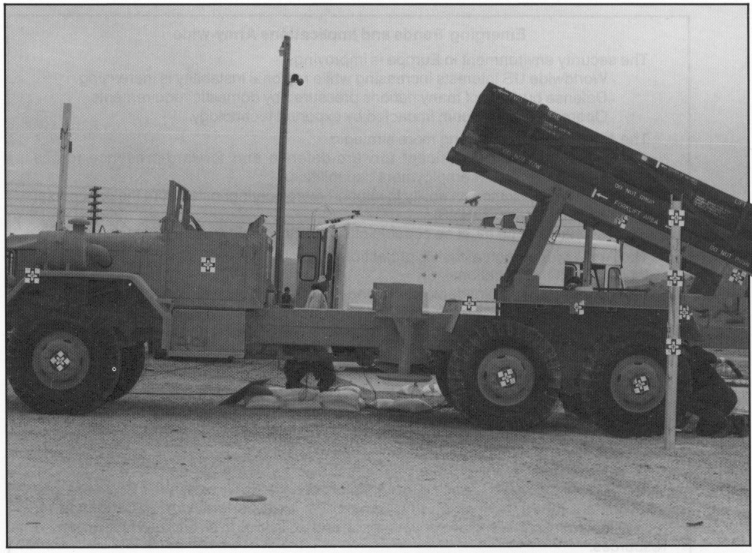
A proof-of-concept prototype of HIMARS at White Sands Missile Range, April 1991
In April 1991, the HIMARS as a concept was tested at the White Sands Missile Range, taking the venerable Honest John truck launcher to evaluate tactical requirements. Then a first vehicle was developed as a private venture by Loral Vought Systems. It was later took over by Lockheed Martin Missiles and Fire Control which added extra resources and engineering to meet the latest requirement. The first workable prototype appeared publicly in 1993. The US Army Missile Command awarded three years later to Lockheed Martin a $23.2 million contract for four refined prototypes with feedback requirements.
In April 1998, these prototypes when completed, were delivered to the XVIII Airborne Corps for a two-year evaluation inside the 3rd Battalion, 27th Field Artillery Regiment and alredady by July first firing tests started. More than a year later by December 1999, the Aviation and Missile Command granted Lockheed Martin the expected $65 million contract for engineering and manufacturing development of the HIMARS. Lockheed Martin then delivered six vehicles, even more closer to production by late 2001 for more evaluation and feedback.
In April 2003, a new contract worth $96 million was signed for a pre-production, low rate for more evaluation in constituted platoons. The Marine Corps was also interested due to its own deployment requirements and placed another order for two and its own evaluation. In the end, after production was setup at Camden, Arkansas, manufacture and assembly of the launcher system and chassis were performed and had been ongoing now until recently. New customers meant it is going to run at least until 2030. It was standardized as the M142, but so far the carrier remained in its original configuration. There is no M142A in plans, however the pod, being modular, saw great strides and innovation in its payloads.
The HIMARS was also tested as a unified launch system to operate the SLAMRAAM, a surface-launched variant of the AMRAAM AA missile. It would be possible in theory as well to adapt the HIMARS to perform SPAAML missions, provided a specialized vehicle could detect, track and define targets via datalink.
The USMC also made interesting developments such as on October 2017. The HIMARS, posted on the amphibious transport dock USS Anchorage, first its rockets against a land target. Quite a valuable asset for a support from standoff range against shore defenses, helped by the modular and flexible architecture of the targeting software since the platform is in motion. It integrates similar parameters as most gun laying systems in the Navy.
By early 2022, Lockheed Martin produced HIMARS at a rate of 48 annually, but with the Russian invasion of Ukraine it rose to 60. In October 2022 it was announced to be pushed to 96 annually, both to provide Ukraine, replacements for the US Army and new orders. The problem is to manage exra industrial capacity on site. It requires substantial efforts to go from 5 to 8 vehicles monthly and an entire new site to achieve double or more.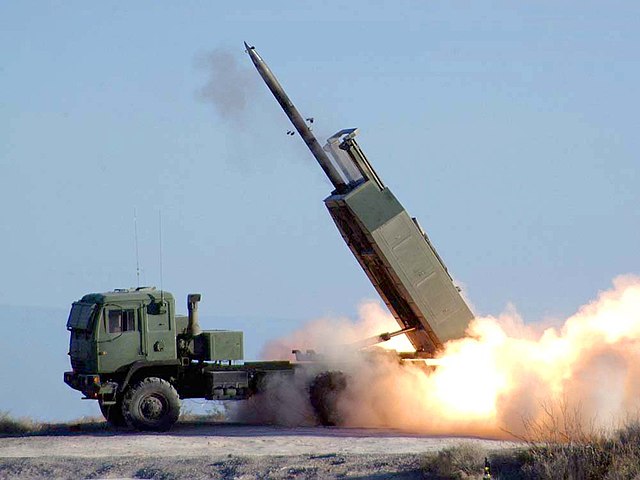
The Family of Medium Tactical Vehicles (FMTV) was initiated to provide a large array of specialized chassis from a common base. With its 6x6 drivetrain, the FMTV derives from the main family of tactical trucks such as the cold war M35 and successors, and WW2 legendary vehicles such as the GMC-353 and Studebaker US7. The FMTV will be developed on truck-encyclopedia, but before this happens, let's have a look at the specific of the M1140 specific chassis. There are in total 26 standardized chassis variants for the FMTV. The initial project initiated in 1988 by GM Military Vehicles, BMY Wheeled Vehicle Division, Harsco Corp. and Teledyne Continental Motors, really started in 1991 as a global replacement for a fleet of 100,000+ cold war vehicles, including the M35. The contract was for 20,000 FMTV in many variants. Oshkosh Defense took pver production after 2009 evaluations with BAE and Navistar Defense.
The M1140 A1/A1R HIMARS High Mobility Artillery Rocket System, launcher chassis was developed specifically with an Armored cab. Indeed the FMTV could come up with softskin cabs, armoured cabins and fully armoured vehicles. The M1140 chassis weights (with the launcher installed) 16,250 kg (35,800 lb) for an overall lenght of 7 m (23 ft) and width of 2.4 m (7 ft 10 in) and an height of 3.2 m (10 ft 6 in). The 6x6 chassis is one of an all-wheel-drive 5t truck motorized with a Caterpillar C7 engine coupled to a 7-speed automatic Allison 3700SP transmission.
The Engine installed in a COE configuration (Cab over Engine) forward is a Caterpillar 3116 ATAAC 6.6-liter diesel rated for 290 hp, with a power/weight ratio of 17.8 hp/t (13.27 kW/t) and for an operational range of 480 km (298-300 mi) and a top speed of 85 km/h (53 mph). The M142 is not amphibious, but still could ford c1 meter (4 ft) of water,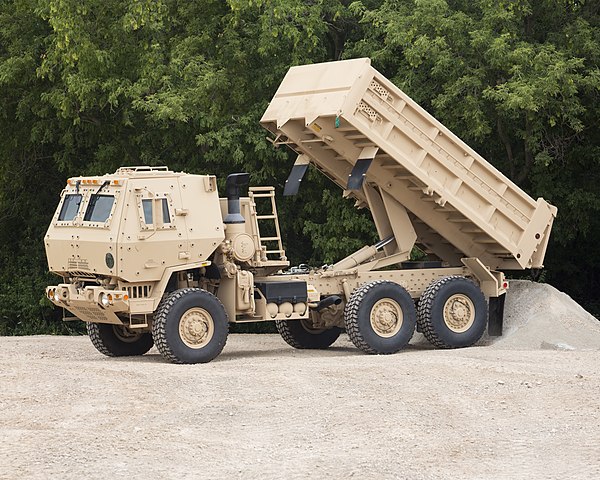
M1157 dump truck, sharing its Enhanced Crew Protected Cab with bolted add-on panels with the M1140.
The cabin is large enougn to house 3-4 personal, with the driver and two operators which could operate the system remotelly from inside the well protected cabin. The cabin accommodating three comprises a gunner and section chief, with the driver seating on the cabin's left side, the gunner and section chief sit on the right side, with access and exit through windowed doors and steps. All three crew members shares an intercom via headgear, and could access to external communication or some vehicle controls depending on their station. The fire control module inside the cabin is a key component of the fire control, with data reception and laying control, pre-loaded and corrected if needed.
Stewart & Stevenson and O'Gara-Hess & Eisenhardt Armoring Company (OHE) developed for the M1140 the "Crew Protected Cab" offering flash and Foreign Object Debris (FOD) protection during launch. The crew cabin provides in its baseline protection against 7.62mm fire and 155mm artillery shell fragments at a certain distance. Next comes the Enhanced Crew Protected Cab, and eventually the Armor Protected Cab, each with exra ballistic protection: Direct small arms fire, then artillery burst and eventually mines and IED thanks to the surelevated cabin, suspended seats and V-type bottom. Its windows are also made of sapphire sheets, laminated with glass and polycarbonate as a coating. The mine/IED protection made for a tall cabin, the M142 is thus not the most dicreet vehicle on the battlefield.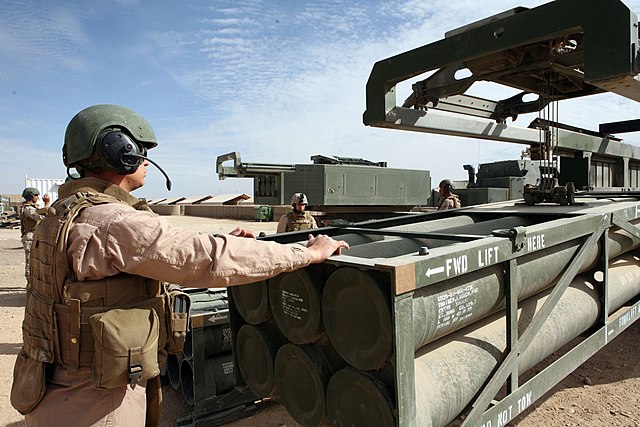
The M142 shares its traversing/elevating mod and most of its hydraullic mechanisms and power unit with the M270 for parts commonality. It is essentially the same launcher, just halved. The advantage is to provide full compatibility with a full family of rockets developed since 1980 (so now over 45 years). The HIMARS rocket launcher system comprises both the launcher-loader module (or pod) and its dedicated fire control module. Mounted on the chassis rear over the twin axle it is in its standard configuration a single six-pack rocket pod adapted for all M270A1 MLRS family or the single, heavy MGM-140 Army Tactical Missile System (ATACMS) for longer, large payload tactical strikes.
The rocket pod is elevating to +60 degrees and traversing to 360 degrees while the fire control module in the cabin, operated by the gunner and section chief displayed received data by the command post or distant station, and includes a fire control computer for isolated unit operation as well as a GPS navigation system and full communication suite. It does not included a battlefield management display but the displays comprises video, keyboard control a one Go data hard drive for program storage.
The FCS is used to find firing solutions and receive target information or communicate with other HIMARS and HQ. It effective firing range depends on its armament, from 9 km (5.6 mi) with the basline MLRS up to 499 km (310 mi) with the new PrSM in development, and a payload of six MLRS, two PrSM or a single MGM-140 ATACMS and an accuracy of 3 feet (1m) for 186 miles or 300 km in range thanks to the GPS-based ballistic computer. The M142 for the moment could not fire on the move.
The MLRS are the baseline 227 mm (9 inches) rockets produced in very large stocks from 1980 onwards in the following variants:
-M26 (644 DPICM M77 submunitions, range: 15–32 km (9.3–19.9 mi).
-M26A1 ER (518 M85 submunitions, Range: 15–45 km (9.3–28.0 mi).
-M26A2 ER (518 M77 submunitions, Range: 15–45 km (9.3–28.0 mi).
-AT2 (German M26 variant, 28 AT2 anti-tank mines, Range 15–38 km (9.3–23.6 mi)
-GLSDB (Swedish M26 flying bomb with SDB.
-M28 rockets (unguided M26): Practice rockets with a 3 ballast/3 smoke-marking containers as payload.
-M28A1 Reduced-Range Practice Rocket (RRPR) with blunt nose, 9 km (5.6 mi) range for practice
-M28A2 Low-Cost Reduced-Range Practice Rocket (LCRRPR) with blunt nose. Range reduced to 9 km (5.6 mi).
The Guided Multiple Launch Rocket System (GMLRS) had the same diameter of 227 mm but extended range and GPS-aided guidance with an internal Inertial Navigation System. They apprared from 2005 and resembled the M30 and M31 rockets (different payloads). On 1 December 2021 50,000 GMLRS were avilable, 9,000 yealy in production. 6 per pod as well. Range 70+ km (43+ mi) but max demo 84 km (52 mi) or 90 km (56 mi) and by 2009 Lockheed Martin announced a prototyoe reached 92 km (57 mi).
-M30A1 AW (Alternative Warhead), Range 15–92 km (9.3–57.2 mi). Carries 182,000 pre-formed tungsten fragments. Started 2015, small pellets for a larger area and proximity sensor fuze, 10m burst height.
-M30A2 rockets with Alternative Warhead (AW), same range, Insensitive Munition Propulsion System (IMPS) (2019)
-M31 rockets: 200 lb (91 kg) HE unitary warhead same range (2005), made by GDES with 51 Ibs(23 kg) PBX-109 HE, steel blast-fragmentation case.
-M31A1 rockets with 200 lb (91 kg) HE unitary warhead, same range 15–92 km (9.3–57.2 mi) but multi-mode fuze wuth airburst at the fuze point detonation and delay.
-M31A2, same warhead, range but Insensitive Munition Propulsion System (IMPS) (2019).
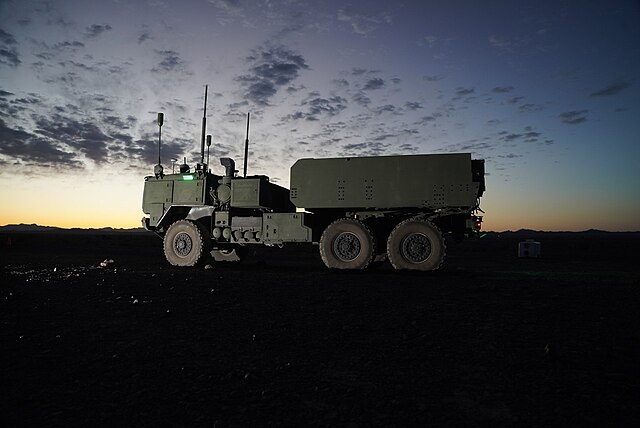
Lockheed Martin UK and INSYS developed a demonstrator vehicle similar to HIMARS answering the current British Army's "Lightweight Mobile Artillery Weapon System/Rocket" program. Same single MLRS pod but mounted on the British Supacat SPV600 chassis. This program was canceled in September 2007.
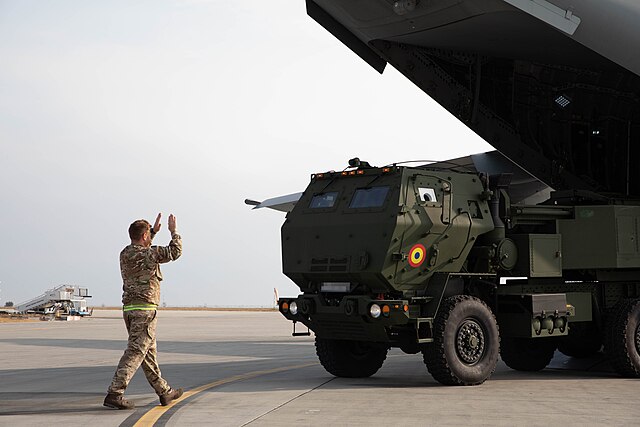
Romanian HIMARS landed from an RAF A400M
HIMARS first entered service in June 2005, tested by the 27th Field Artillery belonging to the 18th Airborne Corps at Fort Bragg in North Carolina. Three prototype were also used during the Iraq War with the first US Marine Corps battalion deploying a few in Iraq in July 2007: The 2nd Battalion, 14th Marine Regiment. In February 2010, the International Security Assistance Force (ISAF) for Afghanistan indicated in a press release announced an error as two rockets fell fallen 300 metres short of their objective, killing 12 in Operation Moshtarak. ISAF suspended the use of the HIMARS wating for a full review of the incident. A British officer corrected this by stating the civilian deaths were due to the Taliban's use of human shields. Another use was in October 2010 during the NATO offensive in Kandahar, with success.
In November 2015 it was revealed 400 were launched in Iraq at ISIL targets since the summer. By March 2016, use in Syria was confirmed for the first time in support of Syrian rebels against ISIL, from Jordan. In January 2016 the system was announced reaching the 1 million operational hours with U.S. forces and a 99% readiness. In April 2016 a deployment in Turkey near Syria was announced to continue actions against ISIL. It was confirmed by early September.
In October 2016 such systems were posted at Qayyarah Airfield West, south of Mosul to take part in the Battle.
In June 2017, a HIMARS was deployed at Al-Tanf in Syria to support rebels and on 24 May 2018 a strike killed 50 Taliban in Musa Qala in Afghanistan with the building in which they resided was razed by three rockets.
In September 2018, a coordination with Syrian Democratic Forces fighting against ISIS in east Syria (Deir ez-Zor campaign= saw 30 strikes per day and further support at the Omar oilfields, 25 km north of the ISIS-controlled targets.
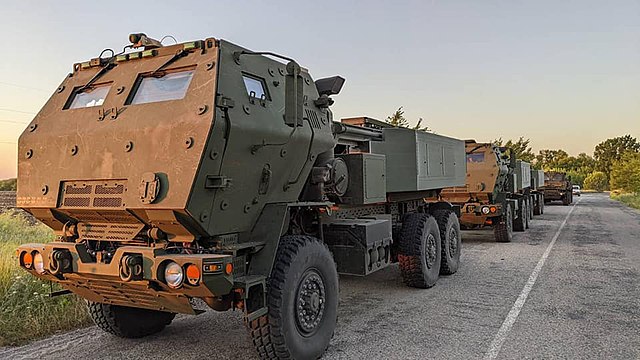
Ukrainian HIMARS at Zaporishya Oblast June 2022
With the invasion of Ukraine, from 1 June 2022, the US DoD announced it would be supplying four HIMARS to Ukraine, and provide M31 GMLRS unitary rockets. On 23 June, the first arrived according to the Ukrainian MoD Oleksii Reznikov. On 25 June 2022 according to CiC Valeriy Zaluzhnyi the system was announced hitting a Russian base in Izyum, killing over 40. The second batch of four was announced by mid-July. Ukraine chose to use the system to destroy Russian command posts as best value targets. On 18 July the system was praised for its surgical strikes on control posts, ammunition and fuel storage depots.
The delivery of the second batch was slow, not by design but because of weeks-long process to train Ukrainian troops and also due to the US still avoiding escalating the conflict, restricted its use into the Russian territory, just the same for the ATACMS missile. A fourth batch of four was announced on 20 July for a total of 16, whereas the Defense Minister Reznikov stated "at least 100" were necessary. So far the few vehicles available destroyed 30 command stations and ammunition storage facilities. A total of 16 was confirmed on 1 August 2022.

On 30 August 2022 the use of wooden decoy HIMARS was used to force the Russians to "spend" 10 3M-54 Kalibr cruise missiles. In 2023 it was confirmed the systems had been used to destroy 400 targets with "devastating effect". A further 18 were announced on 28 September to cover Ukraine's long-term needs and that the new M30A1 using Alternative Warhead were now available for these, taken from US military stockpiles, hoping to have at least 20 HIMARS in Ukrainian service by early 2023. In February CNN reported 9,500 GMLRS rockets had been fired and Russian Defense Minister Sergei Shoigu conversely declared the system a "high priority target".
Best reported use of the HIMARS with the new ammunitions was to strike Russian troop concentrations in the open. One strike in February 2024 with a single of the new rockets killed up to 65 soldiers. Another strike on a Russian base in Makiivka killed 89 Russian soldiers on the admission of the Russian government whereas the BBC News Russian reported "at least" 139. On 5 May 2023 however it was reported Russia was now able to jam GMLRS rockets own GPS guidance system. Yet these rockets kept their "unjammable" inertial navigation system. At last June 2024, another "red line" fell when the US DoD gave permission to Ukrainian forces to use HIMZRS over the Russian territory and notably strike S-300/S-400 SAL system in Belgorod. On 9 August a convoy of Russian troops in the Kursk Oblast was confirmed by Drone video. On 10 February HIMARS were confirmed to be now carried by Antonov Airlines An-124-100M from Harrisburg International Airport in Pennsylvania. On 5 March 2024 a first HIMARS was reported destroyed near Nykanorivka (Donetsk) and a second on 15 August 2024 in Sumy as well as two damaged... so far. Royal Jordanian Army: 12, 29th HIMARS Battalion, Jordan Royal Artillery Command
Royal Jordanian Army: 12, 29th HIMARS Battalion, Jordan Royal Artillery Command
 Polish Land Forces: 20, 16th Mechanised Division
Polish Land Forces: 20, 16th Mechanised Division
 Romanian Land Forces: 54, 8th Tactical Operational Missile Brigade
Romanian Land Forces: 54, 8th Tactical Operational Missile Brigade
 Singapore Army: 24, 23rd Battalion Singapore Artillery
Singapore Army: 24, 23rd Battalion Singapore Artillery
 Republic of China Army: In October 2020, the US government approved the sale of 11 HIMARS to Taiwan, with this initial batch being delivered in November 2024. An additional batch of 18 launchers will be purchased due to the cancellation of M109A6 howitzer orders.
Republic of China Army: In October 2020, the US government approved the sale of 11 HIMARS to Taiwan, with this initial batch being delivered in November 2024. An additional batch of 18 launchers will be purchased due to the cancellation of M109A6 howitzer orders.
 Ukrainian Ground Forces: 38 as of 2024, 3 destroyed by September 2024 (27th Rocket Artillery Brigade)
Ukrainian Ground Forces: 38 as of 2024, 3 destroyed by September 2024 (27th Rocket Artillery Brigade)
 United Arab Emirates Army: 32
United Arab Emirates Army: 32
 US Army: 210th Field Artillery Brigade, 17th Field Artillery Brigade, 18th Field Artillery Brigade, 41st Field Artillery Brigade, 75th Field Artillery Brigade. Army National Guard: 45th, 65th, 115th, 130th, 138th, 142nd, 169th, 197th Field Artillery Brigade. United States Marine Corps: 1st Ba./10th Marine Regiment, 2nd Bat. 10th MRgt, 5th Bat. 11th MRgt, 3rd Bat. 12th MRgt, 2nd Bat. 14th MRgt.
US Army: 210th Field Artillery Brigade, 17th Field Artillery Brigade, 18th Field Artillery Brigade, 41st Field Artillery Brigade, 75th Field Artillery Brigade. Army National Guard: 45th, 65th, 115th, 130th, 138th, 142nd, 169th, 197th Field Artillery Brigade. United States Marine Corps: 1st Ba./10th Marine Regiment, 2nd Bat. 10th MRgt, 5th Bat. 11th MRgt, 3rd Bat. 12th MRgt, 2nd Bat. 14th MRgt.
 The Australian Army as reported by the Pentagon requested to purchase 20 HIMARS for a global of 1-2 billion Australian dollars, a sale approved by the US State Department in May 2022. A total of 42 launchers with a delveri starting in 2026 was conformed as well as over 2000 GMLRS rockets and a domestic production (as seen above) to begin this year (2025).
The Australian Army as reported by the Pentagon requested to purchase 20 HIMARS for a global of 1-2 billion Australian dollars, a sale approved by the US State Department in May 2022. A total of 42 launchers with a delveri starting in 2026 was conformed as well as over 2000 GMLRS rockets and a domestic production (as seen above) to begin this year (2025).
 Croatian Army: According to daily Jutarnji list, negotiations between Croatia and the US were held about a procurement valued $300 million dollars to be concluded by late 2024. The same was approved on 30 August 2024 for eight systems ($390 million).
Croatian Army: According to daily Jutarnji list, negotiations between Croatia and the US were held about a procurement valued $300 million dollars to be concluded by late 2024. The same was approved on 30 August 2024 for eight systems ($390 million).
 Estonian Land Forces: In July 2022, the sale of six systems was approved as part of a package of $500 million.
Estonian Land Forces: In July 2022, the sale of six systems was approved as part of a package of $500 million.
 Italian Army: In December 2023 was announced a "possible sale" of 21 HIMARS worth $400 million. Eventually 14 were ordered in January 2025.
Italian Army: In December 2023 was announced a "possible sale" of 21 HIMARS worth $400 million. Eventually 14 were ordered in January 2025.
 In October 2022, the Latvian MoD announced the acquisition of six systems for $220 million, signed in December 2023 delivery planned FY2027.
In October 2022, the Latvian MoD announced the acquisition of six systems for $220 million, signed in December 2023 delivery planned FY2027.
 In November 2022, the US State Department approved the sale of eight systems, 800 missiles (inc. ATACMS) for $495 million to Lithuania, contract signed by December 2022.
In November 2022, the US State Department approved the sale of eight systems, 800 missiles (inc. ATACMS) for $495 million to Lithuania, contract signed by December 2022.
 In April 2023 the possible sale (not yet concluded) of 18 HIMARS and related ammunitions for $524.2 million to the Royal Moroccan Army.
In April 2023 the possible sale (not yet concluded) of 18 HIMARS and related ammunitions for $524.2 million to the Royal Moroccan Army.
 In August 2024 a sale for 16 vehicles was approved for $580 million to the Norwegian Army.
In August 2024 a sale for 16 vehicles was approved for $580 million to the Norwegian Army.
 The HIMARS was included as part of the Bulgarian Land Forces's Modernization program.
The HIMARS was included as part of the Bulgarian Land Forces's Modernization program.
 The Philippines expressed interest for coastal defense but also considered the BrahMos, K239 Chunmoo and Elbit PULS.
The Philippines expressed interest for coastal defense but also considered the BrahMos, K239 Chunmoo and Elbit PULS.
 Sweden showed interest but no discussions were concluded so far.
Sweden showed interest but no discussions were concluded so far.
 Hungary requested the sale of HIMARS with a deadline of March 2022 but without approval this was considered close. The sale of up to 24 systems was refused on the grounf that Hungary vetoed the entry of Sweden into NATO.
Hungary requested the sale of HIMARS with a deadline of March 2022 but without approval this was considered close. The sale of up to 24 systems was refused on the grounf that Hungary vetoed the entry of Sweden into NATO.
 Royal Netherlands Army: In February 2023 the potential sale of 20 systems was approved for $650 Million but by March 2023, the Netherlands instead purchased 20 Elbit Systems PULS launchers for $133 million. Three argument were brought forward, the price, the capacity (twice as much missiles) and the delivery of the HIMARS hampered by full books until 2026.
Royal Netherlands Army: In February 2023 the potential sale of 20 systems was approved for $650 Million but by March 2023, the Netherlands instead purchased 20 Elbit Systems PULS launchers for $133 million. Three argument were brought forward, the price, the capacity (twice as much missiles) and the delivery of the HIMARS hampered by full books until 2026.
Design
Development

Requirement for HIMARS came about in 1982, when it was needed by 9th (mot) Infantry Division for a light multiple rocket launcher as fast tactical counterfire asset. It was at first ignored by the Field Artillery School with an institutional bias towards heavy forces but as the Cold War ended and low-intensity operations gained favor, the project resurfaced and this time the Field Artillery School and Missile Command found the M270 MLRS too heavy for the new type of warfare in favor from 1992, and notably since the Gulf War as the M270 was too heavy and costly in airlift (Mobilizing a C5 alone). It could only be shipped by sea and missed Desert Storm.

A proof-of-concept prototype of HIMARS at White Sands Missile Range, April 1991
In April 1991, the HIMARS as a concept was tested at the White Sands Missile Range, taking the venerable Honest John truck launcher to evaluate tactical requirements. Then a first vehicle was developed as a private venture by Loral Vought Systems. It was later took over by Lockheed Martin Missiles and Fire Control which added extra resources and engineering to meet the latest requirement. The first workable prototype appeared publicly in 1993. The US Army Missile Command awarded three years later to Lockheed Martin a $23.2 million contract for four refined prototypes with feedback requirements.
In April 1998, these prototypes when completed, were delivered to the XVIII Airborne Corps for a two-year evaluation inside the 3rd Battalion, 27th Field Artillery Regiment and alredady by July first firing tests started. More than a year later by December 1999, the Aviation and Missile Command granted Lockheed Martin the expected $65 million contract for engineering and manufacturing development of the HIMARS. Lockheed Martin then delivered six vehicles, even more closer to production by late 2001 for more evaluation and feedback.
In April 2003, a new contract worth $96 million was signed for a pre-production, low rate for more evaluation in constituted platoons. The Marine Corps was also interested due to its own deployment requirements and placed another order for two and its own evaluation. In the end, after production was setup at Camden, Arkansas, manufacture and assembly of the launcher system and chassis were performed and had been ongoing now until recently. New customers meant it is going to run at least until 2030. It was standardized as the M142, but so far the carrier remained in its original configuration. There is no M142A in plans, however the pod, being modular, saw great strides and innovation in its payloads.
Further Developments

The HIMARS was also tested as a unified launch system to operate the SLAMRAAM, a surface-launched variant of the AMRAAM AA missile. It would be possible in theory as well to adapt the HIMARS to perform SPAAML missions, provided a specialized vehicle could detect, track and define targets via datalink.
The USMC also made interesting developments such as on October 2017. The HIMARS, posted on the amphibious transport dock USS Anchorage, first its rockets against a land target. Quite a valuable asset for a support from standoff range against shore defenses, helped by the modular and flexible architecture of the targeting software since the platform is in motion. It integrates similar parameters as most gun laying systems in the Navy.
By early 2022, Lockheed Martin produced HIMARS at a rate of 48 annually, but with the Russian invasion of Ukraine it rose to 60. In October 2022 it was announced to be pushed to 96 annually, both to provide Ukraine, replacements for the US Army and new orders. The problem is to manage exra industrial capacity on site. It requires substantial efforts to go from 5 to 8 vehicles monthly and an entire new site to achieve double or more.
Design
The HIMARS shared an elevating, traversing pod system similar to the one fitted on the M270 Multiple Launch Rocket System (MLRS). The M142 tactical mobility wheeled vehicle is indeed much faster than the tracked vehicle, used the same type of pods as the M270 but the tradeoff is having just one. The weapon system is composed of a motorized truck chassis, an armoured hull, and a launcher pod, all to be reviewed separately:Chassis: FMTV M1140

The Family of Medium Tactical Vehicles (FMTV) was initiated to provide a large array of specialized chassis from a common base. With its 6x6 drivetrain, the FMTV derives from the main family of tactical trucks such as the cold war M35 and successors, and WW2 legendary vehicles such as the GMC-353 and Studebaker US7. The FMTV will be developed on truck-encyclopedia, but before this happens, let's have a look at the specific of the M1140 specific chassis. There are in total 26 standardized chassis variants for the FMTV. The initial project initiated in 1988 by GM Military Vehicles, BMY Wheeled Vehicle Division, Harsco Corp. and Teledyne Continental Motors, really started in 1991 as a global replacement for a fleet of 100,000+ cold war vehicles, including the M35. The contract was for 20,000 FMTV in many variants. Oshkosh Defense took pver production after 2009 evaluations with BAE and Navistar Defense.
The M1140 A1/A1R HIMARS High Mobility Artillery Rocket System, launcher chassis was developed specifically with an Armored cab. Indeed the FMTV could come up with softskin cabs, armoured cabins and fully armoured vehicles. The M1140 chassis weights (with the launcher installed) 16,250 kg (35,800 lb) for an overall lenght of 7 m (23 ft) and width of 2.4 m (7 ft 10 in) and an height of 3.2 m (10 ft 6 in). The 6x6 chassis is one of an all-wheel-drive 5t truck motorized with a Caterpillar C7 engine coupled to a 7-speed automatic Allison 3700SP transmission.
The Engine installed in a COE configuration (Cab over Engine) forward is a Caterpillar 3116 ATAAC 6.6-liter diesel rated for 290 hp, with a power/weight ratio of 17.8 hp/t (13.27 kW/t) and for an operational range of 480 km (298-300 mi) and a top speed of 85 km/h (53 mph). The M142 is not amphibious, but still could ford c1 meter (4 ft) of water,
Layout and Protection

M1157 dump truck, sharing its Enhanced Crew Protected Cab with bolted add-on panels with the M1140.
The cabin is large enougn to house 3-4 personal, with the driver and two operators which could operate the system remotelly from inside the well protected cabin. The cabin accommodating three comprises a gunner and section chief, with the driver seating on the cabin's left side, the gunner and section chief sit on the right side, with access and exit through windowed doors and steps. All three crew members shares an intercom via headgear, and could access to external communication or some vehicle controls depending on their station. The fire control module inside the cabin is a key component of the fire control, with data reception and laying control, pre-loaded and corrected if needed.
Stewart & Stevenson and O'Gara-Hess & Eisenhardt Armoring Company (OHE) developed for the M1140 the "Crew Protected Cab" offering flash and Foreign Object Debris (FOD) protection during launch. The crew cabin provides in its baseline protection against 7.62mm fire and 155mm artillery shell fragments at a certain distance. Next comes the Enhanced Crew Protected Cab, and eventually the Armor Protected Cab, each with exra ballistic protection: Direct small arms fire, then artillery burst and eventually mines and IED thanks to the surelevated cabin, suspended seats and V-type bottom. Its windows are also made of sapphire sheets, laminated with glass and polycarbonate as a coating. The mine/IED protection made for a tall cabin, the M142 is thus not the most dicreet vehicle on the battlefield.
Launcher and Combat System

The M142 shares its traversing/elevating mod and most of its hydraullic mechanisms and power unit with the M270 for parts commonality. It is essentially the same launcher, just halved. The advantage is to provide full compatibility with a full family of rockets developed since 1980 (so now over 45 years). The HIMARS rocket launcher system comprises both the launcher-loader module (or pod) and its dedicated fire control module. Mounted on the chassis rear over the twin axle it is in its standard configuration a single six-pack rocket pod adapted for all M270A1 MLRS family or the single, heavy MGM-140 Army Tactical Missile System (ATACMS) for longer, large payload tactical strikes.
The rocket pod is elevating to +60 degrees and traversing to 360 degrees while the fire control module in the cabin, operated by the gunner and section chief displayed received data by the command post or distant station, and includes a fire control computer for isolated unit operation as well as a GPS navigation system and full communication suite. It does not included a battlefield management display but the displays comprises video, keyboard control a one Go data hard drive for program storage.
The FCS is used to find firing solutions and receive target information or communicate with other HIMARS and HQ. It effective firing range depends on its armament, from 9 km (5.6 mi) with the basline MLRS up to 499 km (310 mi) with the new PrSM in development, and a payload of six MLRS, two PrSM or a single MGM-140 ATACMS and an accuracy of 3 feet (1m) for 186 miles or 300 km in range thanks to the GPS-based ballistic computer. The M142 for the moment could not fire on the move.
Armament
MLRS (obsolete)

The MLRS are the baseline 227 mm (9 inches) rockets produced in very large stocks from 1980 onwards in the following variants:
-M26 (644 DPICM M77 submunitions, range: 15–32 km (9.3–19.9 mi).
-M26A1 ER (518 M85 submunitions, Range: 15–45 km (9.3–28.0 mi).
-M26A2 ER (518 M77 submunitions, Range: 15–45 km (9.3–28.0 mi).
-AT2 (German M26 variant, 28 AT2 anti-tank mines, Range 15–38 km (9.3–23.6 mi)
-GLSDB (Swedish M26 flying bomb with SDB.
-M28 rockets (unguided M26): Practice rockets with a 3 ballast/3 smoke-marking containers as payload.
-M28A1 Reduced-Range Practice Rocket (RRPR) with blunt nose, 9 km (5.6 mi) range for practice
-M28A2 Low-Cost Reduced-Range Practice Rocket (LCRRPR) with blunt nose. Range reduced to 9 km (5.6 mi).
GMLRS

The Guided Multiple Launch Rocket System (GMLRS) had the same diameter of 227 mm but extended range and GPS-aided guidance with an internal Inertial Navigation System. They apprared from 2005 and resembled the M30 and M31 rockets (different payloads). On 1 December 2021 50,000 GMLRS were avilable, 9,000 yealy in production. 6 per pod as well. Range 70+ km (43+ mi) but max demo 84 km (52 mi) or 90 km (56 mi) and by 2009 Lockheed Martin announced a prototyoe reached 92 km (57 mi).
M30 family rockets
-Baseline M30: 404 DPICM M101 submunitions, Range 15–92 km (9.3–57.2 mi). 3,936 produced 2004-2009, upgrdes.-M30A1 AW (Alternative Warhead), Range 15–92 km (9.3–57.2 mi). Carries 182,000 pre-formed tungsten fragments. Started 2015, small pellets for a larger area and proximity sensor fuze, 10m burst height.
-M30A2 rockets with Alternative Warhead (AW), same range, Insensitive Munition Propulsion System (IMPS) (2019)
-M31 rockets: 200 lb (91 kg) HE unitary warhead same range (2005), made by GDES with 51 Ibs(23 kg) PBX-109 HE, steel blast-fragmentation case.
-M31A1 rockets with 200 lb (91 kg) HE unitary warhead, same range 15–92 km (9.3–57.2 mi) but multi-mode fuze wuth airburst at the fuze point detonation and delay.
-M31A2, same warhead, range but Insensitive Munition Propulsion System (IMPS) (2019).
ER GMLRS rockets
Extended range (ER): 150 km (93 mi), slightly increased rocket motor, new hull, tail-driven guidance in unitary and AW variants (2021). Lockheed Marti extecpted a FY2023 contract award and production at Camden for a full operational capability in 2025. Finland ordered it followed by Lithuania in Nov. 2022 then Poland in February 2023.GLSDB
Ground Launched Small Diameter Bomb. M26-rocket based (Boeing+Saab) based on the GBU-39 Small Diameter Bomb and M26 rocket motor, range 150 km (93 mi).ATACMS
The Army Tactical Missile System, 610 mm SSM, range of up to 300 km (190 mi).M39 (ATACMS BLOCK I)
Baselined model with inertial guidance, housing 950 M74 Anti-personnel/materiel (APAM) bomblets. Range: 25–165 km (16–103 mi). 1,650 produced 1990-1997. 32 fired in Desert Stor and 379 in Operation Iraqi Freedom. Remaining updated to M57E1 standard.M39A1 (ATACMS BLOCK IA)
Add a GPS-aided guidance and 300 M74 APAM bomblets, range 20–300 km (12–186 mi). 610 produced 1997-2003, 75 fired in Operation Iraqi Freedom, remaining updated to M57E1 standard.M48 (2001)
ATACMS Quick Reaction Unitary (QRU): GPS-aided guidance, same 500-pound (230 kg) WDU-18/B penetrating HE blast-Frag warhead as the Harpoon missile, range: 70–300 km (43–186 mi). 176 made 2001-2004. 16 fired at Operation Iraqi Freedom, 42 at Enduring Freedom.M57 (ATACMS TACMS 2000)
Same with the WAU-23/B warhead and range. 513 produced 2004-2013.M57E1 (ATACMS Modification; MOD)
GPS-aided guidance. Upgraded M39/M39A1, re-grained motor, updated navigation/guidance software/hardware, WAU-23/B warhead, M74 APAM bomblets, proximity sensor for airburst detonation. Prod. 2017-23 (220 upgrades). Replacement planned by the Precision Strike Missile (PrSM).PrSM
The Precision Strike Missile: GPS-guided, area-effects warhead, range of 60–499 km (37–310 mi). 2 missiles pod for HIMARS, but high cost, low-rate prod. 110 delivered per year, in service from 2023.Variants
LIMAWS(R)

Lockheed Martin UK and INSYS developed a demonstrator vehicle similar to HIMARS answering the current British Army's "Lightweight Mobile Artillery Weapon System/Rocket" program. Same single MLRS pod but mounted on the British Supacat SPV600 chassis. This program was canceled in September 2007.
Australian GMLRS
Lockheed Martin and Thales Australia were in discussion about manufacturing GMLRS rockets in Australia in the wake of the AUKUS agreement, notably to have a local supply in case of war with China. The agreements precised the technology and guidance components, authorized by the US government. In November 2022 "The Strategist" warned that acquition without a dedicated surveillance and target acquisition capability negated the benefice of that production for the US alone.Autonomous Multi-domain Launcher
Abbreviated as AML this unmanned variant of the HIMARS is equipped with remote control and fire-control but retained the M270 MLRS and HIMARS full capabilities with the difference that the AML could now carry two pods. Still in early development phase, for a possible replacement of the HIMARS in the 2030s+.Homar-A
Thus Polish MoD program was developed in the wake of the National Defense plan to acquire this rocket launcher capability for a possible future war with Russia. The program includes local production via technology transfers, notably an integration of the pod on the domestic Jelcz 663.45 6x6 truck chassis but also the Polish "Topaz" battle management system and communication system. The framework agreement with Lockheed Martin was signed back in September 11, 2023 for a future delivery of 486 Homar-A vehicles, assembled in Poland starting from 2026.GMARS
In 2023, Rheinmetall and Lockheed Martin signed a collaboration agreement for the GMARS, constisting in a dual pod and using the same family of munitions but also the AGM-158 JASSM and 122 mm unguided rockets in future upgrades. The chassis type is still in discussion but the concept was unveiled at Eurosatrory 2024 showing Rheinmetall's HX 8x8 chassis. Lockheed Martin sees this as an entry point on the European Market. Video.| Dimensions (L-w-H) | 7 m (23 ft) x 2.4 m (7 ft 10 in) x 3.2 m (10 ft 6 in) |
| Total weight | 16,250 kg (35,800 lb) |
| Crew | 3: Driver, gunner, chief operator |
| Propulsion | Caterpillar 3116 ATAAC 6.6-liter diesel 290 hp |
| Transmission | See notes |
| Maximum speed | 85 km/h (53 mph) |
| Suspensions | Coils, leaf, hydraulic |
| Range (Fuel) | 480 km (300 mi) |
| Armor | 6mm, see notes |
| Production | c600, in progress |
Operational Service

Romanian HIMARS landed from an RAF A400M
HIMARS first entered service in June 2005, tested by the 27th Field Artillery belonging to the 18th Airborne Corps at Fort Bragg in North Carolina. Three prototype were also used during the Iraq War with the first US Marine Corps battalion deploying a few in Iraq in July 2007: The 2nd Battalion, 14th Marine Regiment. In February 2010, the International Security Assistance Force (ISAF) for Afghanistan indicated in a press release announced an error as two rockets fell fallen 300 metres short of their objective, killing 12 in Operation Moshtarak. ISAF suspended the use of the HIMARS wating for a full review of the incident. A British officer corrected this by stating the civilian deaths were due to the Taliban's use of human shields. Another use was in October 2010 during the NATO offensive in Kandahar, with success.
In November 2015 it was revealed 400 were launched in Iraq at ISIL targets since the summer. By March 2016, use in Syria was confirmed for the first time in support of Syrian rebels against ISIL, from Jordan. In January 2016 the system was announced reaching the 1 million operational hours with U.S. forces and a 99% readiness. In April 2016 a deployment in Turkey near Syria was announced to continue actions against ISIL. It was confirmed by early September.
In October 2016 such systems were posted at Qayyarah Airfield West, south of Mosul to take part in the Battle.
In June 2017, a HIMARS was deployed at Al-Tanf in Syria to support rebels and on 24 May 2018 a strike killed 50 Taliban in Musa Qala in Afghanistan with the building in which they resided was razed by three rockets.
In September 2018, a coordination with Syrian Democratic Forces fighting against ISIS in east Syria (Deir ez-Zor campaign= saw 30 strikes per day and further support at the Omar oilfields, 25 km north of the ISIS-controlled targets.

Ukrainian HIMARS at Zaporishya Oblast June 2022
With the invasion of Ukraine, from 1 June 2022, the US DoD announced it would be supplying four HIMARS to Ukraine, and provide M31 GMLRS unitary rockets. On 23 June, the first arrived according to the Ukrainian MoD Oleksii Reznikov. On 25 June 2022 according to CiC Valeriy Zaluzhnyi the system was announced hitting a Russian base in Izyum, killing over 40. The second batch of four was announced by mid-July. Ukraine chose to use the system to destroy Russian command posts as best value targets. On 18 July the system was praised for its surgical strikes on control posts, ammunition and fuel storage depots.
The delivery of the second batch was slow, not by design but because of weeks-long process to train Ukrainian troops and also due to the US still avoiding escalating the conflict, restricted its use into the Russian territory, just the same for the ATACMS missile. A fourth batch of four was announced on 20 July for a total of 16, whereas the Defense Minister Reznikov stated "at least 100" were necessary. So far the few vehicles available destroyed 30 command stations and ammunition storage facilities. A total of 16 was confirmed on 1 August 2022.

On 30 August 2022 the use of wooden decoy HIMARS was used to force the Russians to "spend" 10 3M-54 Kalibr cruise missiles. In 2023 it was confirmed the systems had been used to destroy 400 targets with "devastating effect". A further 18 were announced on 28 September to cover Ukraine's long-term needs and that the new M30A1 using Alternative Warhead were now available for these, taken from US military stockpiles, hoping to have at least 20 HIMARS in Ukrainian service by early 2023. In February CNN reported 9,500 GMLRS rockets had been fired and Russian Defense Minister Sergei Shoigu conversely declared the system a "high priority target".
Best reported use of the HIMARS with the new ammunitions was to strike Russian troop concentrations in the open. One strike in February 2024 with a single of the new rockets killed up to 65 soldiers. Another strike on a Russian base in Makiivka killed 89 Russian soldiers on the admission of the Russian government whereas the BBC News Russian reported "at least" 139. On 5 May 2023 however it was reported Russia was now able to jam GMLRS rockets own GPS guidance system. Yet these rockets kept their "unjammable" inertial navigation system. At last June 2024, another "red line" fell when the US DoD gave permission to Ukrainian forces to use HIMZRS over the Russian territory and notably strike S-300/S-400 SAL system in Belgorod. On 9 August a convoy of Russian troops in the Kursk Oblast was confirmed by Drone video. On 10 February HIMARS were confirmed to be now carried by Antonov Airlines An-124-100M from Harrisburg International Airport in Pennsylvania. On 5 March 2024 a first HIMARS was reported destroyed near Nykanorivka (Donetsk) and a second on 15 August 2024 in Sumy as well as two damaged... so far.
Operators
 Royal Jordanian Army: 12, 29th HIMARS Battalion, Jordan Royal Artillery Command
Royal Jordanian Army: 12, 29th HIMARS Battalion, Jordan Royal Artillery Command Polish Land Forces: 20, 16th Mechanised Division
Polish Land Forces: 20, 16th Mechanised Division Romanian Land Forces: 54, 8th Tactical Operational Missile Brigade
Romanian Land Forces: 54, 8th Tactical Operational Missile Brigade Singapore Army: 24, 23rd Battalion Singapore Artillery
Singapore Army: 24, 23rd Battalion Singapore Artillery Republic of China Army: In October 2020, the US government approved the sale of 11 HIMARS to Taiwan, with this initial batch being delivered in November 2024. An additional batch of 18 launchers will be purchased due to the cancellation of M109A6 howitzer orders.
Republic of China Army: In October 2020, the US government approved the sale of 11 HIMARS to Taiwan, with this initial batch being delivered in November 2024. An additional batch of 18 launchers will be purchased due to the cancellation of M109A6 howitzer orders. Ukrainian Ground Forces: 38 as of 2024, 3 destroyed by September 2024 (27th Rocket Artillery Brigade)
Ukrainian Ground Forces: 38 as of 2024, 3 destroyed by September 2024 (27th Rocket Artillery Brigade) United Arab Emirates Army: 32
United Arab Emirates Army: 32 US Army: 210th Field Artillery Brigade, 17th Field Artillery Brigade, 18th Field Artillery Brigade, 41st Field Artillery Brigade, 75th Field Artillery Brigade. Army National Guard: 45th, 65th, 115th, 130th, 138th, 142nd, 169th, 197th Field Artillery Brigade. United States Marine Corps: 1st Ba./10th Marine Regiment, 2nd Bat. 10th MRgt, 5th Bat. 11th MRgt, 3rd Bat. 12th MRgt, 2nd Bat. 14th MRgt.
US Army: 210th Field Artillery Brigade, 17th Field Artillery Brigade, 18th Field Artillery Brigade, 41st Field Artillery Brigade, 75th Field Artillery Brigade. Army National Guard: 45th, 65th, 115th, 130th, 138th, 142nd, 169th, 197th Field Artillery Brigade. United States Marine Corps: 1st Ba./10th Marine Regiment, 2nd Bat. 10th MRgt, 5th Bat. 11th MRgt, 3rd Bat. 12th MRgt, 2nd Bat. 14th MRgt.
Future Operators and failed bids
 The Australian Army as reported by the Pentagon requested to purchase 20 HIMARS for a global of 1-2 billion Australian dollars, a sale approved by the US State Department in May 2022. A total of 42 launchers with a delveri starting in 2026 was conformed as well as over 2000 GMLRS rockets and a domestic production (as seen above) to begin this year (2025).
The Australian Army as reported by the Pentagon requested to purchase 20 HIMARS for a global of 1-2 billion Australian dollars, a sale approved by the US State Department in May 2022. A total of 42 launchers with a delveri starting in 2026 was conformed as well as over 2000 GMLRS rockets and a domestic production (as seen above) to begin this year (2025).
 Croatian Army: According to daily Jutarnji list, negotiations between Croatia and the US were held about a procurement valued $300 million dollars to be concluded by late 2024. The same was approved on 30 August 2024 for eight systems ($390 million).
Croatian Army: According to daily Jutarnji list, negotiations between Croatia and the US were held about a procurement valued $300 million dollars to be concluded by late 2024. The same was approved on 30 August 2024 for eight systems ($390 million).
 Estonian Land Forces: In July 2022, the sale of six systems was approved as part of a package of $500 million.
Estonian Land Forces: In July 2022, the sale of six systems was approved as part of a package of $500 million.
 Italian Army: In December 2023 was announced a "possible sale" of 21 HIMARS worth $400 million. Eventually 14 were ordered in January 2025.
Italian Army: In December 2023 was announced a "possible sale" of 21 HIMARS worth $400 million. Eventually 14 were ordered in January 2025.
 In October 2022, the Latvian MoD announced the acquisition of six systems for $220 million, signed in December 2023 delivery planned FY2027.
In October 2022, the Latvian MoD announced the acquisition of six systems for $220 million, signed in December 2023 delivery planned FY2027.
 In November 2022, the US State Department approved the sale of eight systems, 800 missiles (inc. ATACMS) for $495 million to Lithuania, contract signed by December 2022.
In November 2022, the US State Department approved the sale of eight systems, 800 missiles (inc. ATACMS) for $495 million to Lithuania, contract signed by December 2022.
 In April 2023 the possible sale (not yet concluded) of 18 HIMARS and related ammunitions for $524.2 million to the Royal Moroccan Army.
In April 2023 the possible sale (not yet concluded) of 18 HIMARS and related ammunitions for $524.2 million to the Royal Moroccan Army.
 In August 2024 a sale for 16 vehicles was approved for $580 million to the Norwegian Army.
In August 2024 a sale for 16 vehicles was approved for $580 million to the Norwegian Army.
 The HIMARS was included as part of the Bulgarian Land Forces's Modernization program.
The HIMARS was included as part of the Bulgarian Land Forces's Modernization program.
 The Philippines expressed interest for coastal defense but also considered the BrahMos, K239 Chunmoo and Elbit PULS.
The Philippines expressed interest for coastal defense but also considered the BrahMos, K239 Chunmoo and Elbit PULS.
 Sweden showed interest but no discussions were concluded so far.
Sweden showed interest but no discussions were concluded so far.
 Hungary requested the sale of HIMARS with a deadline of March 2022 but without approval this was considered close. The sale of up to 24 systems was refused on the grounf that Hungary vetoed the entry of Sweden into NATO.
Hungary requested the sale of HIMARS with a deadline of March 2022 but without approval this was considered close. The sale of up to 24 systems was refused on the grounf that Hungary vetoed the entry of Sweden into NATO.
 Royal Netherlands Army: In February 2023 the potential sale of 20 systems was approved for $650 Million but by March 2023, the Netherlands instead purchased 20 Elbit Systems PULS launchers for $133 million. Three argument were brought forward, the price, the capacity (twice as much missiles) and the delivery of the HIMARS hampered by full books until 2026.
Royal Netherlands Army: In February 2023 the potential sale of 20 systems was approved for $650 Million but by March 2023, the Netherlands instead purchased 20 Elbit Systems PULS launchers for $133 million. Three argument were brought forward, the price, the capacity (twice as much missiles) and the delivery of the HIMARS hampered by full books until 2026.
Gallery
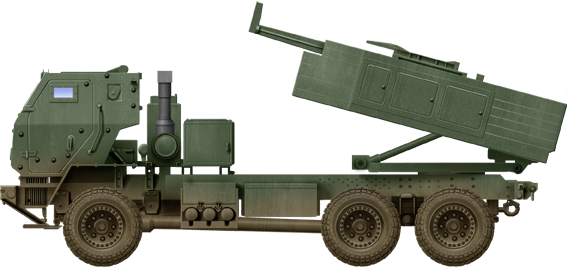
Base M142 in original standard US Army dark olive Green

M142 used in Afghanistan and Iraq in sand livery, in transit.














Sources
On lockheedmartin.comOn armyrecognition.com/
twz.com
cat-uxo.com
On military.com
theguardian.com
On bbc.com
acq.osd.mil
army.mil
dsca.mil procurement to Lithuania
dvidshub.net
forbes.com

Modern Tanks
Modern MBTs posters

Denel Bagder (2018)

Type 16 MCV (2016)

Gepard 1A2 last rounds 2011

SANDF

Russian AFVs

Main Battle Tanks
